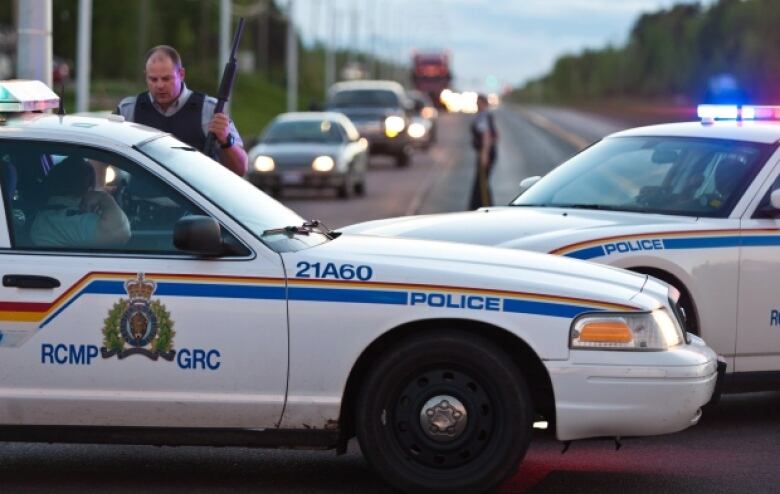No one took command in Moncton shootings 'chaos,' RCMP labour code trial hears
Force charged with violating Canada Labour Code in connection with deaths of 3 officers, wounding of 2

A retired RCMP assistant commissioner who led a review ofthe policeresponse to Justin Bourque'sdeadly shooting rampage in Moncton, N.B., in 2014testified Wednesday that no one took command during the "chaos."
About 20 officers rushed in unaware of what they were dealing with andwere unprepared, AlphonseMacNeiltold theRCMP'slabour code trial inMoncton.
Although the officers were used to responding to gun calls, most involvedair guns or BB guns, he said.
"Over time, people let their guard down, for lack of a better word."
The officers, who were on different radio channels, didn't even realize their colleagues had been shot and killed, said MacNeil.
A supervisor should have come over the air and advised the responding officers what to do, he said.
"Nobody was actually taking control."
- Carbines would have been most effective weapon for RCMP in Moncton shootings, trial hears
- 'We were feeling like the hunted,'wounded Mountie recalls
- 'Oh God, he's got an automatic': RCMP supervisor recountsMoncton shootings
TheRCMPis on trial in connection with the shooting deaths of three officers that night and the wounding of two others.
The national police force ischarged with violating four provisions of the Labour Codeby allegedly failing to provide members with appropriate use-of-force equipmentand trainingfor responding to an active threat or active shooting event, and failing to ensurethe health and safety of every person employed by the force.
Tactical disadvantage
MacNeil's2015 report on the shootings made 64 recommendations, including that frontline officers be immediately equipped with patrol carbineshigh-powered, short-barrelled rifles that havea longer and more accurate range than a pistol or shotgun.
Bourquewas armed with anM305.308 semi-automatic rifle and aMossberg500 12-gauge shotgun during his shooting spree in a residential area of Moncton's north end on June 4, 2014.The responding officers were equipped only with pistols and shotguns.

MacNeil reiterated Wednesday thatthe lack offirepowerwas a key areaof concern, because it put the officers at a tactical disadvantage. They had to get close to Bourque because of theshort range of their weapons and their lesser accuracy, presenting a risk to civilians.
Several of the officers who were interviewed for the report "talked about the positive difference it would have been to have a carbine," he said. Carbines would have given them "more lethal force ability" and increased confidence levels.
No carbines were available to the officers on the night of the shootings,the trial, now in its fourth week, has heard.
They were doing the best they could with what they had.- Alphonse MacNeil, retired RCMP assistant commissioner
The detachment did have some .308 rifles, but they hadn't been serviced since 2002, leaving officers with little confidence in the weapons, MacNeil found. Many members said they were uncomfortable with using shotguns because they weren't familiar with them or didn't like the recoil.
MacNeil noted theRCMP is "generally not compliant" with weapon recertification for its members and some were not up to date with their pistols.
The Moncton situation alsorequired officers to run and shoot and hit moving targets, which they weren't trained to do.
- On mobile? Follow our live coverage here.
The other main concernMacNeilidentified was that many members weren't wearing the new hard bodyarmourthat was still in the packing in the trunks of their vehicles. There was a definite lack of awareness, he said.
"No one went on air to say, 'We're in a shooting situation, put on your hard bodyarmour,'" saidMacNeil.
In a paramilitary organization like theRCMP, people are used to working together, he said. But witha shooter on the loose and numerous officers responding,someone needed to step in and make decisions, "and no one took on that role."

Instead, the initial responderswere left to make their own decisions, and within about 20 minutes, five of them were gunned down.
MacNeilstressed he wasn't being critical of the officers' actions, and said he understands it was a difficult and emotional situation.
"They were doing the best they could with what they had," he said.
Confusion, lack of co-ordination
Officers "unfortunately" gathered at the fire station on HildegardDrive, which was in the "hot zone," and no one took the initiative to block the street, where several pedestrians andchildren on bicycles were out enjoying the nice weather.
Even after the shootings and into the following morning when officers from other detachments were arriving for the manhunt, there was "still a lot of confusion and lack of co-ordination," said MacNeil, who reviewed the radio dispatch recordings.
Prior to that night, the RCMP did not offer enough front-line supervisors the proper training to take control of such situations, he said.
"In a perfect world It's not a perfect world, I guess is the best way to say it."
Revisions requested
MacNeil started working on his reviewin early July 2014, and recruited an internal team of firearms experts and good investigators, the courtroom heard.
"It was made clear to me I would have 90 days," he said, and an interim report was expected within 45 days.
He submitted his report to the RCMP in October 2014 and was asked tomake changes, he said.
Some of the changes were acceptable, he said, and he made them. But he declined to make others, such as reducing the number of recommendations, he said.
The RCMP did not ask him to change the content of the report, which was released in January 2015, he said.
Bourqueis serving five life sentences with no chance of parole for 75 years after pleading guilty to three counts of first-degree murder and two counts of attempted murder.
Two months have been set aside for the labour codetrial, which started April 24.
The trial is scheduled to resume on Friday morning when the defence is expected to call its first witness.
Each of the four charges carries a maximum fine of $1 million.
With files from Tori Weldon












_(720p).jpg)


 OFFICIAL HD MUSIC VIDEO.jpg)
.jpg)



























































































